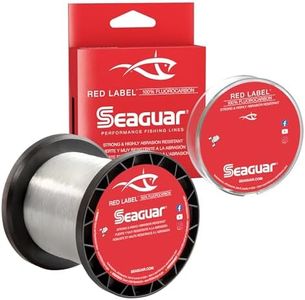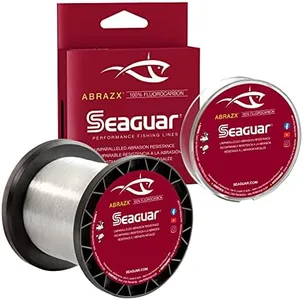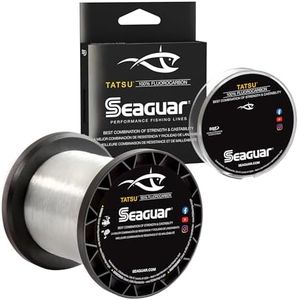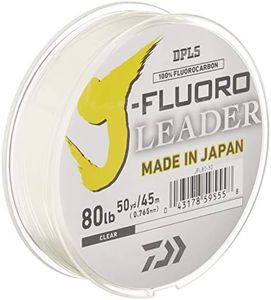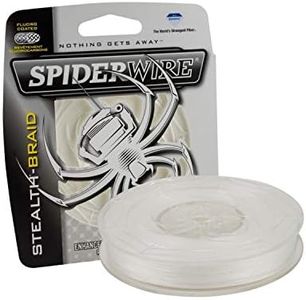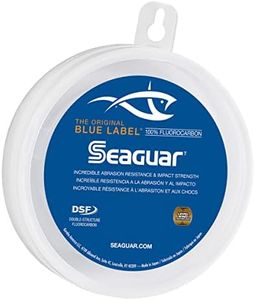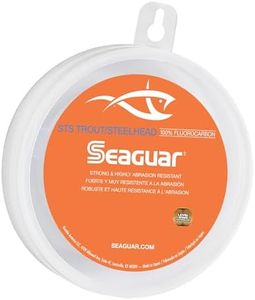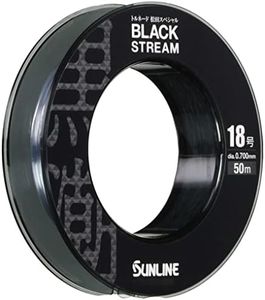We Use CookiesWe use cookies to enhance the security, performance,
functionality and for analytical and promotional activities. By continuing to browse this site you
are agreeing to our privacy policy
10 Best Fluorocarbon Fishing Line
From leading brands and best sellers available on the web.Buying Guide for the Best Fluorocarbon Fishing Line
Choosing the right fluorocarbon fishing line can make a big difference in your fishing experience. The ideal line depends on factors like the type of fish you're targeting, water clarity, and your fishing technique. Understanding the main specifications will help you choose a line that fits your needs and maximizes your chances of success on the water.Line Strength (Pound Test)Line strength, often called the 'pound test,' tells you how much weight the line can support before breaking. This is crucial because it determines what size fish you can safely catch without the line snapping. Lower pound tests, typically from 2 to 8 pounds, are suitable for light tackle and smaller fish, making them a good choice for finesse fishing and clear water where fish may be line-shy. Middle range values, around 10 to 20 pounds, are versatile and suited for bass, walleye, or similar fish. Higher pound tests, over 20 pounds, are for bigger game fish or when fishing in heavy cover. Think about the species you target and the conditions you face; if you target small trout in clear streams, go for the lower range, but if you chase big bass in heavy vegetation, choose something stronger.
Line DiameterThe thickness of the fishing line, or its diameter, affects both how visible the line is underwater and how well it casts. Thinner lines are less visible and allow for more natural lure presentations, which matter in clear water or when fish are easily spooked. Thicker lines are more abrasion resistant and stronger but can be more visible and heavier, affecting casting distance and lure action. Choose a thinner diameter for stealth and finesse, and a thicker one when fighting abrasive structures or larger fish.
Abrasion ResistanceAbrasion resistance refers to how well the line withstands friction or contact with rough surfaces like rocks, logs, or docks. High abrasion resistance is important if you fish in areas with lots of underwater obstacles, as it reduces the chance of your line getting damaged or breaking. Lower abrasion resistance may be acceptable in open waters with few snags. Assess where you fish most often; if there’s lots of cover or rough terrain, prioritize higher abrasion resistance.
VisibilityOne of the main reasons anglers pick fluorocarbon is its low visibility underwater. This means fish are less likely to notice the line, which can increase bites in clear or pressured waters. Thicker lines and those with glossy finishes can be a bit more visible. When fishing clear lakes or streams, prioritize a line known for being as invisible as possible. For murkier or stained water, visibility may not matter as much.
Knot StrengthKnot strength measures how well the line holds up when tied in various fishing knots. Some lines lose a lot of their strength once a knot is tied, making them prone to breaking at the knot. Strong knot performance is important if you use knots frequently or fight hard-pulling fish. If you’re new to fishing, pick a line known for being forgiving and strong with common knots to avoid losing fish due to knot failure.
StretchStretch determines how much the line elongates under pressure. Fluorocarbon generally stretches less than other types of line, providing better sensitivity to detect bites and quicker hooksets. Minimal stretch is best for applications where feeling subtle bites is important, like jig fishing or drop shotting. Some anglers prefer a bit more give to act as a cushion for hard-fighting fish. Decide based on whether you want maximum sensitivity or a bit of shock absorption.
Sink RateFluorocarbon lines naturally sink, unlike some other types which float. This matters if you want your lure or bait to get down deeper and stay in the strike zone longer. Faster sink rates are helpful for bottom fishing or using deep-diving lures. For topwater techniques, a slower sink or floating line may be better, but for most uses, the sink rate of fluorocarbon is an advantage, especially if you want to target fish holding near the bottom.
